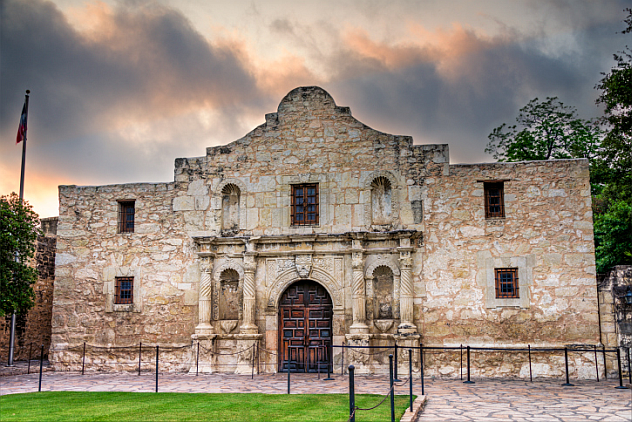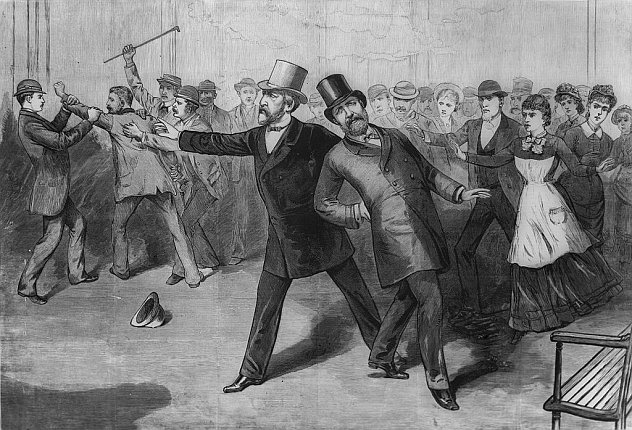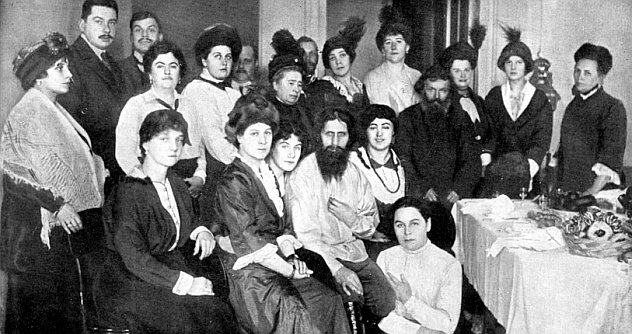 Technology
Technology  Technology
Technology  Humans
Humans 10 Everyday Human Behaviors That Are Actually Survival Instincts
 Animals
Animals 10 Animals That Humiliated and Harmed Historical Leaders
 History
History 10 Most Influential Protests in Modern History
 Creepy
Creepy 10 More Representations of Death from Myth, Legend, and Folktale
 Technology
Technology 10 Scientific Breakthroughs of 2025 That’ll Change Everything
 Our World
Our World 10 Ways Icelandic Culture Makes Other Countries Look Boring
 Misconceptions
Misconceptions 10 Common Misconceptions About the Victorian Era
 Mysteries
Mysteries 10 Strange Unexplained Mysteries of 2025
 Miscellaneous
Miscellaneous 10 of History’s Most Bell-Ringing Finishing Moves
 Technology
Technology Top 10 Everyday Tech Buzzwords That Hide a Darker Past
 Humans
Humans 10 Everyday Human Behaviors That Are Actually Survival Instincts
 Animals
Animals 10 Animals That Humiliated and Harmed Historical Leaders
Who's Behind Listverse?

Jamie Frater
Head Editor
Jamie founded Listverse due to an insatiable desire to share fascinating, obscure, and bizarre facts. He has been a guest speaker on numerous national radio and television stations and is a five time published author.
More About Us History
History 10 Most Influential Protests in Modern History
 Creepy
Creepy 10 More Representations of Death from Myth, Legend, and Folktale
 Technology
Technology 10 Scientific Breakthroughs of 2025 That’ll Change Everything
 Our World
Our World 10 Ways Icelandic Culture Makes Other Countries Look Boring
 Misconceptions
Misconceptions 10 Common Misconceptions About the Victorian Era
 Mysteries
Mysteries 10 Strange Unexplained Mysteries of 2025
 Miscellaneous
Miscellaneous 10 of History’s Most Bell-Ringing Finishing Moves
10 Deaths That Might Not Have Happened The Way You Think
Generally speaking, a person dies, and the details get reported in the newspaper, or whatever was in style at the time. However, accuracy is sometimes inaccurate. Sometimes it’s misreporting, but sometimes details are deliberately left out to carve a different narrative. What follows are a few from history that stand out.
10 Davy Crockett

You’ve probably heard of him: Davy, Davy Crockett, alleged King of the Wild Frontier. “Kilt him a b’ar” when it was politically correct to do so, at the tender age of three. He was already pretty well known when Walt Disney made a motion picture chronicling his heroic stand at the Alamo. Crockett is best remembered as being the last man standing, swinging his rifle as Mexican troops stormed the Alamo. Turns out that Disney might not be the best of historians.
Lt. Col. Jose Enrique de la Pena didn’t have an axe to grind against Crockett or the Texans. You could even make the case that de la Pena liked them more than his superior, General Santa Anna, who he referred to as a euphemism for the male sexual organ. De la Pena kept a diary that became lost to time for over 100 years. When it was published in 1955, it made the extraordinary claim that Crockett did not die swinging his rifle, but rather he surrendered and was executed the following day with some other men who had surrendered with him. “Among them,” de la Pena wrote, “was one of great stature, well-formed and with regular features, in whose face was stamped the pain of adversity, but naturalist David Croket [sic], very well known in North America for his novel adventures.”
Ramon Martinez Caro, Santa Anna’s personal secretary, wrote a contemporary document in 1839 which states similar facts: “Among the 183 killed there were five who were discovered by General Castrillon hiding after the assault. He took them immediately to the presence of His Excellency who had come up by this time. When he presented the prisoners he was severely reprimanded for not having killed them on the spot, after which he turned his back upon Castrillon while the soldiers stepped out of their ranks and set upon the prisoners until they were all killed . . . We all witnessed this outrage which humanity condemns but which was committed as described. This is a cruel truth, but I cannot omit it.”
American historians, especially those who were pro-Crockett, quickly jumped on the de la Pena diary as a forgery. The argument is that the forgery is based on the Caro description of the massacre, and Crockett’s name was added in by a forger from the 20th century. After all, the diary became public knowledge at the height of Crockett’s American rebirth in 1955, right when the Disney movie hit theaters. So which is correct? Disney or the 2004 Alamo movie that tells the de la Pena version?
There’s one more account that ties them together: George M. Dolson wrote a letter to his brother in 1836, shortly after the Alamo battle. In it, he echoes the de la Pena and Caro stories, and claims that Crockett was indeed captured and executed. A New Orleans newspaper reported the same story three weeks after the event. The stories that match the 1955 Disney film are based on reports from Mexican troops that say one particular soldier was tough to bring down, but no one could say with certainty that that was Crockett. The evidence shows, however, that the Mexicans detained and executed Davy Crockett after the battle.
9 Cassie Bernall

One of the lasting stories of the tragedy of the Columbine High School shooting in 1999 was the dual cold-hearted actions of the killers and the defiant faith of one of the victims. According to reports at the time, Eric Harris pointed a gun at Cassie Bernall and asked her if she believed in God. She calmly answered, “Yes.” Harris murdered her with one shot to the head. Her unflappable faith became a rallying cry, and her mother published a book. But the conversation never took place.
The truth has always been there, and the September 24, 1999 edition of the Rocky Mountain News reported an accurate description of Bernall’s murder. Dylan Klebold, the other of the two Columbine shooters, slammed his hand on a table, said “Peekaboo,” and crouched down to find Bernall and Emily Wyant hiding. Without uttering a word, Klebold shot Bernall in the head. There was indeed an exchange between murderer and victim about God, but it wasn’t Bernall. Valeen Schnurr cried out, “Oh, my God, oh, my God, don’t let me die,” as she bled from 34 shotgun pellet wounds. Klebold approached her and asked her why she believed in God. She replied that she was brought up that way. Klebold reloaded but did not shoot Schnurr again.
The original report came from a Salon.com story. If you want to be kind you can say that some facts got mixed up along the way, but the reality is that Bernall never had a chance to speak before Klebold killed her.
8 Laika

One of the most famous dogs in modern history got her start on the mean streets of Moscow. The female mutt named Laika became an overnight sensation when she became the first living creature from Earth to sail into space. Scientist Vladimir Yazdovsky knew her fate was sealed, so days before the mission he took her home to play with his children. The dog was destined to die in space, as there was no re-entry plan to retrieve her. The official version said that Laika survived a few days and then was euthanized by a programmed injection.
The Soviet government didn’t always tell the truth. In 2002, the accurate story finally came out. The official story would make it seem that the test was more successful than it actually was, because Laika died a few hours after blastoff. The temperature was to be stable inside the capsule, with a fan triggering if temperatures rose above 15 degrees Celsius (59 °F). The fan never triggered as the capsule became very hot, which was unexpected. Somewhere around five to seven hours into the flight, the capsule showed no life signs; Laika had died from overheating. Her pulse rate shot up by a factor of three above its resting level after the launch, but stabilized after weightlessness. But the dog obviously suffered great stress, as it took a very long time to stabilize. So rather than a peaceful passing, Laika likely suffered the whole time in space and died painfully in a defective spacecraft.
7 Cleopatra

We at Listverse like setting the record straight about famous people, like when we told you that Cleopatra looked more like a poor man’s Bea Arthur than Elizabeth Taylor. At least her infamous death by an asp is a well-documented fact, right?
The earliest report of Cleopatra’s method of suicide was by the writer Strabo, who lived contemporaneously with the Queen. He didn’t exactly clear it up, stating that it was either an asp or a poison ointment. Most historians latched onto the asp story, because let’s face it, poisoning yourself with an Egyptian cobra is so much cooler than just rubbing yourself with poison and sitting there.
Modern research shows that one of Strabo’s accounts is likely correct, and it’s not the snake one. Christoph Schaefer, a professor of Ancient History at Trier University, says that clearly Cleopatra did not die from a snakebite. His research—based on other text reporting her death as quick—rules out an asp bite. An Egyptian cobra bite is not always fatal, and the death takes hours while paralysis slowly sets in. Considering that Cleopatra took two of her handmaidens with her to the afterlife (why not?), the notion that all three would line up for asps and all three would die is remarkable. According to the historian Plutarch, one handmaiden was still alive when Octavian’s men found the queen dead. That alone rules out an asp bite; all three women would be paralyzed before dying. A cobra could not be the genesis of the bite either as they dispense all their venom in one bite, making three bites impossible. Working with a German toxicologist, Schaefer determined that it was likely hemlock, mixed with wolfsbane and opium, that took down the queen.
Contemporary reports of the asp bite are present, but “contemporary” is a relative term. Most are from 50–100 years later, and at that time the asp death was more meaningful for an Egyptian queen. The snake suicide was taken more as a symbolic method, rather than an actual means of death. It wasn’t until the 15th century that artwork would depict Cleopatra ending it all via the snake. Shakespeare included the asp legend in his work Antony and Cleopatra. But the reality is that poisoning, as reported by Strabo, is the true cause of Cleopatra’s death.
6 James Garfield

Being one of the four US presidents assassinated is usually the only reason anyone remembers James Garfield today, or else it’s the other trivial fact: He could write in Greek and Latin simultaneously as he was ambidextrous. His assassination shocked the American public as he was a mere four months into his presidency when shot.
The thing is that the assassin’s bullet didn’t kill Garfield. Doctors did. On July 2, 1881, Garfield was shot by Charles Guiteau as the President waited for a train in Washington, D.C. Guiteau actually landed two slugs in Garfield, one in the arm and one that ultimately came to rest in his spine. Doctors immediately tried to fish the bullet out of his spine, sticking fingers, probes, and whatever unsanitary items they could find into Garfield. The American doctors thought the most important thing to saving Garfield was the bullet removal, and had no idea that they could actually make him sicker—mainly because most didn’t believe germs existed. Englishman Joseph Lister began using antiseptics almost 20 years earlier, but Americans still acted like the Brit was practicing witchcraft and rejected antiseptics in favor of brandy and other things for the President’s pain.
President Garfield suffered for 80 days. He was unable to eat, and lost 35–60 kilograms (80–130 lb). The President’s assassin said, “I shot him, but doctors killed him.” And surprisingly, the guy so delusional to think it was a divine mission to terminate Garfield was right. Thirty-one years later, Teddy Roosevelt was on the receiving end of a bullet from an assassin. Unlike Garfield, doctors left the bullet right there, and it remained with him for the rest of his life. So it’s highly likely that had doctors done nothing, Charles Guiteau would be a failed assassin, and James Garfield would have survived.
5 The Challenger Crew

To a lot of North Americans born between the late 1960s and 1980, it’s their first “flashbulb memory”—where were you when the Space Shuttle Challenger blew up? The crew of the Challenger met their end 73 seconds into the ill-fated January 1986 flight. Or did they?
The official NASA version doesn’t implicitly state when the seven astronauts died. To most watching, seeing the gigantic explosion was enough to know that the astronauts died instantly. The explosion was the solid rocket booster, and the capsule carrying the crew actually propelled upward to almost 20,000 meters (65,000 ft) before tumbling to the ocean almost three minutes later. Some of the emergency air bottles were activated, so clearly not everyone died immediately. It’s likely that all seven were alive when the pod hit the water.
The cabin became crushed upon impact with the water, and the bodies were entangled with the wreckage. Dr. Joseph Kerwin, director of Life Sciences at Johnson Space Center said in 1986 that the force of the explosion, despite how spectacular it looked on TV, was not great enough to cause death to the crew. Pilot Michael Smith, who infamously uttered, “Uh oh” as the last communication from Challenger, had his air activated for him—it was located behind his seat and he obviously couldn’t get out and do it himself. Because of a lack of damage to the floor of the cabin, it depressurized slowly rather than rapidly. The evidence shows that it was the tremendous force of striking the ocean that killed the Challenger crew, not the explosion.
4 Elvis

If you’re a wee bit older, you may have a flashbulb memory about where you were when Elvis died, and may think that The King died on the toilet. Officially, the autopsy report said Elvis Presley died of a heart attack. Of course, the ample supply of prescription drugs didn’t do anything to help him, and many believe that the cause of death for Elvis was an overdose.
The reality is that Elvis didn’t die on the toilet; he was on the floor of the bathroom and dressed. There is no doubt that Presley abused prescription drugs for years prior to his death, but most agree that one specific thing killed The King: constipation. The average person’s colon is 120–150 centimeters (4–5 ft) long, and Elvis was the king of colons, measuring in at 275 centimeters (9 ft) long. Colon flushing is all the rage nowadays, but the reality is that it’s not necessary because the body doesn’t normally store feces like that. Unless you’re Elvis, who had four- or five-month-old stool lining the walls of his colon.
Presley had bowel paralysis, which is exactly what it sounds like: It’s difficult to poop. Because of the strain one puts into forcing a bowel movement, it puts a strain on the heart. To deal with his abdominal pain, Elvis took codeine and hydrocodone, which are known to cause constipation. So when you factor in the cocktail of prescription drugs, an enlarged heart, and the pressure from straining, that’s what did Elvis in. Yes, Elvis had a heart attack, but it was his constipation that caused it, not the drugs.
3 Alexander Hamilton

It’s easily the most infamous duel in American history; the sitting Vice President gunned down one of the most famous politicians in the US. Aaron Burr became a pariah after that (it’s not like he was a good guy anyway, he tried to form his own country after all). Alexander Hamilton is recalled as a noble man who simply fired in the air, while Burr coldly murdered him.
After the duel, Hamilton’s men sprung into action, declaring that Hamilton had no intention to shoot Burr. They produced letters—including one to his wife—that painted a sincere picture of a humble man who only wanted peace. And that’s how it’s recalled in history books. However, a 1976 study by Smithsonian Magazine examined the guns used in the duel and discovered a previously unknown detail: The guns had a hair trigger. In layman’s terms, that means that the slightest movement would cause the gun to fire. As Hamilton chose the guns (and supplied them), he obviously knew the gun had a hair trigger, whereas Burr likely did not. Using a hair trigger in a duel was a breach of protocol and very undignified. As the gun is lowered, the trick with the hair trigger is to fire early and (in theory) strike the opponent. If Hamilton truly intended to fire in the air, he wouldn’t need a hair trigger. Burr reported that Hamilton’s shot buzzed by his ear, narrowly taking some of his head off. The key advantage is that Burr would use the slower pull on the trigger to fire, which would naturally throw off his aim.
Hamilton shot first, but in his haste to get the drop on Burr he fired just a fraction too early (and too much to the left). He probably realized the second he missed that he was a goner. Because Hamilton missed, the hair trigger didn’t factor into throwing off Burr; he knew he could take his time, aim, and fire. The method of Hamilton’s death doesn’t change, but the story behind it does. Aaron Burr isn’t exactly the bad guy in the duel—he was simply firing back after Hamilton almost took his head off using a trick gun to try and kill him.
2 Che Guevara

The exact details of Che Guevara’s death have always been a bit of a political struggle. Those who like to wear his image on their shirts believe the version that has Che defiant and cocky as he faced the barrel of a gun, while the other side of the aisle likes to recall the racist, murdering Che begging for his life as he died. Well, we’re not about to decide that for you. This is more about exactly how he became captured and about who helped the Americans learn where he was.
The United States was strongly anti-communist in the 1960s; they’d pretty much do anything to prevent more countries within their sphere of influence from turning Red. And since politics makes strange bedfellows, the CIA jumped in the sack with a Nazi. According to filmmaker Kevin McDonald, the US government recruited Klaus Barbie, the infamous Gestapo butcher who was at that time hiding in Bolivia, to help capture Che. Barbie and the US had one thing in common: They both detested Communists. One of Barbie’s duties had been to thwart the French Resistance in World War II, so the US wanted to pick his brain on how to stop Guevara’s efforts to turn Bolivia Communist. The story might not be as far-fetched as it seems. Barbie had good influence in Bolivia, and he received ample protection from pro-Fascist forces, so if the US really wanted to know what was going on in the area, Barbie was the man to see.
Guevara met his end in 1967. Barbie boasted to anyone who’d listen that he delivered the plan to get Che. Even Fidel Castro believed that the Nazi and the Americans talked shop to take down the revolutionary.
1 Kitty Genovese

The senseless murder of Kitty Genovese is one of the most studied murders in modern history. As you probably know, bystanders—as many as 38—stood by and did nothing while a young woman was murdered within their view. The eyewitnesses seemed to speak volumes about how people react to tragedy, the coldness of New York in general, and whatever any psychologist wanted to fit into their little box of speculation.
It is accurate that Genovese was viciously attacked on March 13, 1964 in Queens. Winston Moseley attacked Genovese a little after 3:00 AM as she returned home after her work shift. Robert Moser heard the commotion from across the street. He yelled out and Moseley ran off. A 14-year-old boy also heard and saw the attack and told his father, who called the police. A man was seen running from the scene, and a woman was staggering in the opposite direction.
The police didn’t respond to the phone call. Moseley, realizing that no sirens were coming, turned back toward the direction Genovese traveled and found her passed out at her building’s vestibule. There, he stabbed and raped her. It was that second attack that proved fatal to Genovese. It was the New York Times that originally reported the 38 eyewitnesses (they also reported three attacks, not the two that actually occurred). Karl Ross, who was a friend of Genovese, actually witnessed the attack from his doorway. Ross was a bit of a paranoid and an alcoholic, and when Moseley saw him, Ross slammed his door shut and crawled out his window to a neighbor’s apartment. After a long period of time, he called the police, but by then Genovese was dead.
The people of Kew Gardens were seen as monsters. Sophie Farrar, an upstairs tenant, raced down the stairs in an attempt to save Genovese. She was too far gone by her arrival, and Farrar’s act of heroics is forgotten. All that is recalled is that 38 witnesses stood by and did nothing. In truth, only one did nothing (not counting the police), but at least four tried to save her life.
+ Rasputin

You know the infamous name of Rasputin: Russian faith healer, adviser to the Tsar Nicholas II and his Tsarina wife Alexandra, and an awesome dancer from Just Dance. The Russian Rasputin was the priest who wouldn’t die, despite being drugged, shot, and drowned.
However, Rasputin’s death didn’t exactly go down as you may think. The British Secret Service was likely behind the murder. According to Andrew Cook, a key cog in the assassination was Oswald Rayner—a friend of Prince Felix Yusupov, the head assassin. Turns out Rayner was actually a British Secret Service officer. Rasputin had a bullet wound to the forehead, which Cook alleges is the telltale sign of a professional assassin. Maybe Rasputin was indeed drugged, shot, and then thrown into a river to drown, but Richard Cullen, a retired Scotland Yard detective, insists that after Rasputin showed faint signs of life, Rayner put a bullet in his brain at close range. Autopsies showed Rasputin had three wounds from three different guns. A British Agent provided the third gun and the fatal shot.








